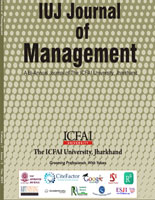(Dr. Akinchan Buddhodev Sinha - Deputy Director ICSI , Arindam Sinha - Academician and Researcher )
Keywords : Growth of MSMEs in India; Role of MSMEs in stimulating entrepreneurship; Government schemes
EOI : eoi.citefactor.org/10.11224/IUJ.09.02.01



 The IUJ Journal of Management (IUJ-JOM) is the flagship journal of ICFAI University Jharkhand, Ranchi.
The aim of the journal is to provide insight into the business and management research. It also creates
a platform for the researchers, academicians, professors , practicing management professionals and proponents
in disseminating original,
The IUJ Journal of Management (IUJ-JOM) is the flagship journal of ICFAI University Jharkhand, Ranchi.
The aim of the journal is to provide insight into the business and management research. It also creates
a platform for the researchers, academicians, professors , practicing management professionals and proponents
in disseminating original,
theoretical and applied research in the field of management and allied disciplines. The Journal is a Bi-Annual, . . . . .Read more.
 Micro, small and medium enterprises play a pivotal role in the socio-economic development of the country. They are considered as engine of growth. Besides addressing the issues of unemployment and poverty, it assists prodigiously in generating additional family income.
. . . .
Read more.
Micro, small and medium enterprises play a pivotal role in the socio-economic development of the country. They are considered as engine of growth. Besides addressing the issues of unemployment and poverty, it assists prodigiously in generating additional family income.
. . . .
Read more.
 These are the informal groups formed by women for addressing their routine problems of socio-economic in nature. These groups function with a common and general objective of cooperation and mutual trust and support. Even though the initiation of the Self Help Groups could be seen since 1975 the NABARD formally started this concept in 1986-87.
Read more.
These are the informal groups formed by women for addressing their routine problems of socio-economic in nature. These groups function with a common and general objective of cooperation and mutual trust and support. Even though the initiation of the Self Help Groups could be seen since 1975 the NABARD formally started this concept in 1986-87.
Read more.
 In Marxian perspective the state is an instrument in the hands of the capitalists who use it to increases their profit through exploitation of labor. “Hatecariat” class has emerged in contemporary India as the result of an innovation strategy introduced by the rich and the powerful. The Nov 8, 2016 demonetization of higher denomination currency notes is taken as a case in point.
Read more.
In Marxian perspective the state is an instrument in the hands of the capitalists who use it to increases their profit through exploitation of labor. “Hatecariat” class has emerged in contemporary India as the result of an innovation strategy introduced by the rich and the powerful. The Nov 8, 2016 demonetization of higher denomination currency notes is taken as a case in point.
Read more.
Subscribe now to get notified about IU Jharkhand journal updates!
(Dr. Akinchan Buddhodev Sinha - Deputy Director ICSI , Arindam Sinha - Academician and Researcher )
Keywords : Growth of MSMEs in India; Role of MSMEs in stimulating entrepreneurship; Government schemes
EOI : eoi.citefactor.org/10.11224/IUJ.09.02.01
( Dr. Venkata Somanadh Kolluru, Dr.Subrato Kumar Dey)
Keywords : Self Help Groups (SHGs), NABARD, India, Maharashtra, Wardha District
EOI : eoi.citefactor.org/10.11224/IUJ.09.02.02
( Naseer Mohamed Jaffer, Maria Thomas, Datta Indrani Karanam )
Keywords : Proletariat, Precariat, Hatecariat, Crony Capitalism
EOI : eoi.citefactor.org/10.11224/IUJ.09.02.03
( Ruchi Gupta )
Keywords : Self Help Group, SBLP, NABARD, poverty, banking sector, women group
EOI : eoi.citefactor.org/10.11224/IUJ.09.02.04
( Dr. Sonika Sharma )
Keywords : Recruitment, Selection, Technology, Employee, Change
EOI : eoi.citefactor.org/10.11224/IUJ.09.02.05
( Sanjay Kumar Jena , Dr Manish Kumar , Dr Rabinarayan Patnaik )
Keywords : Over-the-Top service, Consumer decision-making, Online streaming, viewership
EOI : eoi.citefactor.org/10.11224/IUJ.09.02.06
( Animesh Karn, Arohi Anand )
Keywords : gross domestic product, gross national happiness, Legatum prosperity index, measures of prosperity, sustainable development goals.
EOI : eoi.citefactor.org/10.11224/IUJ.09.02.07
( Rajesh Kumar Yadav , Dr. Rumna Bhattacharya )
Keywords : Coal, Corona, Covid-19, Corona warriors, Energy, Frontline workers.
EOI : eoi.citefactor.org/10.11224/IUJ.09.02.08
( Dr. Prakash b. Kundaragi )
Keywords : Women, Empowerment, SHG’s
EOI : eoi.citefactor.org/10.11224/IUJ.09.02.09
( Balkrishna Singh, Dr. Vishal Kumar )
Keywords : Women, Empowerment, SHG’s
EOI : eoi.citefactor.org/10.11224/IUJ.09.02.10
( Dr. Rajeev Kumar, Dr. Dilip Kumar )
Keywords : Information and Communication Technology (ICT), Retailer, Organizational Performance.
EOI : eoi.citefactor.org/10.11224/IUJ.09.02.11
( Kusum Kanan Mishra )
Keywords : Women, Self Help groups, empowerment, training
EOI : eoi.citefactor.org/10.11224/IUJ.09.02.12
( Sumit Mishra , Dr. Bhagabat Barik )
Keywords : Rural online shopping, consumer buying behaviour, perceived risk, trust, purchase intention.
EOI : eoi.citefactor.org/10.11224/IUJ.09.02.13
( Anjan Niyogi , Dr. Pallavi Kumari )
Keywords : Senior Citizen, Hearing Aids, Quality of life, Ageism, Hearing Impairment
EOI : eoi.citefactor.org/10.11224/IUJ.09.02.14
( Ms. Puja K. Gulhane , Dr. S. R. Chavan )
Keywords : SHGs, Entrepreneurship, Economic Development, Skill Development, Micro Credit
EOI : eoi.citefactor.org/10.11224/IUJ.09.02.15
( Dr Vandana Pareek , Dr. Manish Kumar Yadav , Dr. Om Prakash Singh )
Keywords : festivals, income households, perception, customers, loyalty
EOI : eoi.citefactor.org/10.11224/IUJ.09.02.16
